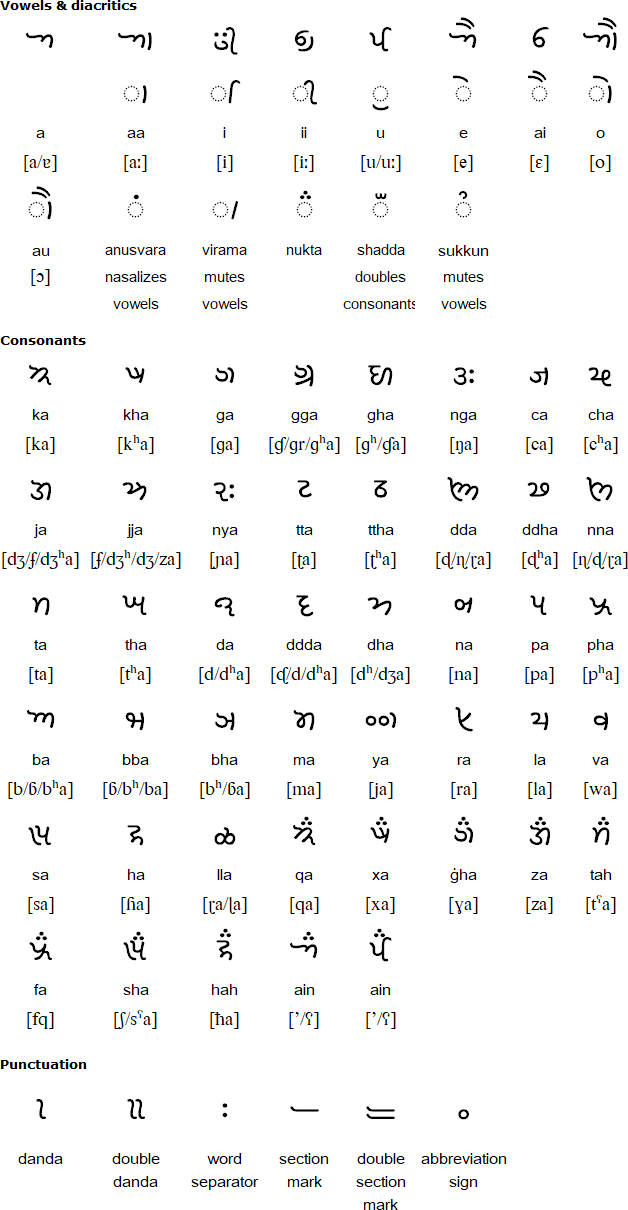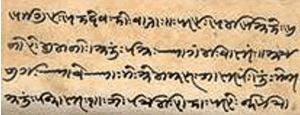Khojki or Khojiki was used almost exclusively by the Khoja community in parts of South Asia such as Sindh in southern Pakistan. It was used mainly for Shia Muslim Ismaili religious literature, as well as literature for a few secret Shia Muslim sects. Khojki is still used to some extent by the Ismaili religious community.
According to the Nizari Ismaili tradition Khojki was created by Pir Sadardin, an Ismaili missionary who worked with the Hindu Lohana community of Sind during the 15th century. Khojki first appears in manuscripts in around 1737 and was thought to have become distinct from the Landa alphabet during the 16th century.
Many books and lithographs in Khojki were published in the 20th century after metal types for Khojki were produced by Laljibhai Devraj.
The name Khojki comes from the Sindhi word khojā, from the Persian word خواجہ (ḵẖwājah - master, lord). Literally it means "of the master".

Download an alphabet chart for Khojki
Details provided by Biswajit Mandal (biswajitmandal[dot]bm90[at]gmail[dot]com)

Source: http://ismailimail.wordpress.com/2011/01/29/khojki-script/
Information about the Khojki alphabet
http://en.wikipedia.org/wiki/Khojki
http://www.ismaili.net/granths/script.html
http://www.iis.ac.uk/view_article.asp?ContentID=104533
http://ismaili.net/heritage/files/khojki-unicode.pdf
Ahom, Aima, Arleng, Badagu, Badlit, Basahan, Balinese, Balti-A, Balti-B, Batak, Baybayin, Bengali, Bhaiksuki, Bhujimol, Bilang-bilang, Bima, Blackfoot, Brahmi, Buhid, Burmese, Carrier, Chakma, Cham, Cree, Dehong Dai, Devanagari, Dham Lipi, Dhankari / Sirmauri, Ditema, Dives Akuru, Dogra, Ethiopic, Evēla Akuru, Fox, Fraser, Gond, Goykanadi, Grantha, Gujarati, Gunjala Gondi, Gupta, Gurmukhi, Halbi Lipi, Hanifi, Hanuno'o, Hočąk, Ibalnan, Incung, Inuktitut, Jaunsari Takri, Javanese, Kaithi, Kadamba, Kamarupi, Kannada, Kawi, Kharosthi, Khema, Khe Prih, Khmer, Khojki, Khudabadi, Kirat Rai, Kōchi, Kodava Lipi, Komering, Kulitan, Kurukh Banna, Lampung, Lanna, Lao, Lepcha, Limbu, Lontara/Makasar, Lota Ende, Magar Akkha, Mahajani, Malayalam, Meitei (Modern), Manpuri (Old), Marchen, Meetei Yelhou Mayek, Meroïtic, Masarm Gondi, Modi, Mon, Mongolian Horizontal Square Script, Multani, Nandinagari, Newa, New Tai Lue, Ojibwe, Odia, Ogan, Pahawh Hmong, Pallava, Phags-pa, Purva Licchavi, Qiang / Rma, Ranjana, Rejang (Kaganga), Sasak, Savara, Satera Jontal, Shan, Sharda, Sheek Bakrii Saphaloo, Siddham, Sinhala, Sorang Sompeng, Sourashtra, Soyombo, Sukhothai, Sundanese, Syloti Nagri, Tagbanwa, Tai Noi, Takri, Tamil, Tanchangya (Ka-Pat), Tani, Thaana, Telugu, Thai, Tibetan, Tigalari, Tikamuli, Tocharian, Tolong Siki, Vatteluttu, Warang Citi
Page last modified: 16.03.23
[top]
You can support this site by Buying Me A Coffee, and if you like what you see on this page, you can use the buttons below to share it with people you know.

If you like this site and find it useful, you can support it by making a donation via PayPal or Patreon, or by contributing in other ways. Omniglot is how I make my living.
Note: all links on this site to Amazon.com, Amazon.co.uk
and Amazon.fr
are affiliate links. This means I earn a commission if you click on any of them and buy something. So by clicking on these links you can help to support this site.
[top]